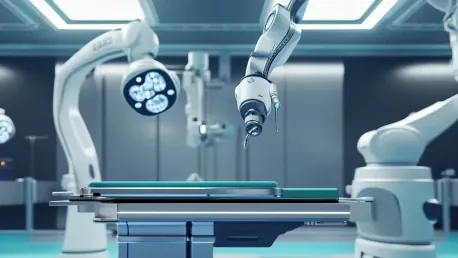The surgical robotics market is experiencing rapid growth and transformation, driven by technological advancements, increased competition, and broader market pressures. As healthcare continues to advance, hospitals and medical institutions are increasingly adopting robotic systems to enhance the precision, efficiency, and safety of surgical procedures. With a projected value of $2.9 billion in 2024, this industry is on an upward trajectory, expected to reach a staggering $9.2 billion by 2034. This significant growth not only highlights the importance of robotic systems in modern medicine but also underscores the increasing reliance on these advanced technologies for complex surgeries.
Market Overview
The surgical robotics market is poised to experience exponential growth over the next decade. Projections indicate a substantial rise in market value, from an estimated $2.9 billion in 2024 to an impressive $9.2 billion by 2034. Such a trajectory underscores the widening acceptance and integration of robotic systems in surgical practices. This trend is driven by the myriad benefits that these systems offer, including enhanced precision in surgical procedures, reduced recovery times for patients, and increased operational efficiency for medical institutions.
Leading the charge in this burgeoning market is Intuitive Surgical, whose da Vinci robotic system commands nearly 60% of the market share as of 2024. The dominance of the da Vinci system sets a daunting benchmark for emerging competitors, compelling them to innovate and differentiate their offerings to capture a share of this lucrative market. Intuitive Surgical’s established presence and trusted reputation make it a formidable player, setting high standards that aspiring market entrants must strive to meet or exceed.
Intuitive Surgical’s Dominance
Intuitive Surgical has consistently been a trailblazer in the surgical robotics market, maintaining its leadership position through relentless innovation and strategic market maneuvers. By early 2025, the company’s market cap had soared to an impressive $206.6 billion, reflecting its robust market position and investor confidence. The Q4 2024 revenue of $2.4 billion marked a notable 25% increase from the previous year, further solidifying the company’s stronghold in the industry.
A significant milestone for Intuitive Surgical was the launch of its latest iteration, the da Vinci 5 system, which received FDA clearance in March 2024. This new system introduces a host of significant upgrades that enhance its overall performance. Key advancements include improved case insights and AI-driven comparisons to best practices, both of which enhance surgical accuracy and decision-making. Additionally, ergonomic improvements ensure that surgeons can operate more efficiently and comfortably, thereby reducing fatigue and increasing overall productivity.
The company’s strategy extends beyond product innovation. Intuitive Surgical is actively acquiring businesses in several European countries to establish a direct presence and strengthen its market foothold. This strategic expansion not only broadens the company’s geographic reach but also facilitates better customer service and localized support. Although the company remains tight-lipped about its specific plans for 2025, it is evident that Intuitive Surgical is committed to continuous development and exploring new applications for its advanced robotic system.
Emerging Competitors
While Intuitive Surgical remains a dominant force in the market, the competitive landscape is evolving with the entry of formidable challengers. Medtronic’s Hugo robot has emerged as a noteworthy competitor, particularly in Europe where it has been in use since its introduction in 2022. Hugo’s modular build and open console setup make it a versatile option, particularly attractive for teaching and training purposes. Its high-resolution vision system further enhances surgical precision, making it a compelling alternative to the da Vinci system.
Medtronic is channeling its efforts towards gaining FDA approval for Hugo’s urology applications in early 2025, with plans to expand its indications to include hernia and gynecology procedures subsequently. Hugo’s slightly lower price point compared to da Vinci is a strategic advantage that may appeal to cost-conscious medical institutions looking to adopt robotic surgical systems. However, Medtronic’s realistic target is to establish itself as a strong number two player in the market, acknowledging the substantial head start that Intuitive holds.
Joining the competitive fray is Johnson & Johnson (J&J) with its Ottava system. Although J&J has been relatively tight-lipped about its specific plans for 2025, the company has made significant strides, including securing an FDA investigational device exemption (IDE) to initiate clinical trials. The Ottava system aims to differentiate itself by offering a fully integrated and flexible solution, focusing on workflow efficiency and a reduced footprint. J&J faces challenges similar to those of Medtronic, such as obtaining regulatory approvals and gaining acceptance from surgeons through comprehensive training programs.
Technological Advancements
Technological advancements are at the heart of the rapid evolution in the surgical robotics market. Companies are leveraging cutting-edge innovations to enhance the capabilities of their robotic systems, thereby driving the market forward. One of the most impactful developments is the integration of AI-driven insights and cloud-based data comparisons. These technologies enable surgeons to access real-time data and best-practice guidelines, improving decision-making and surgical outcomes. AI-driven comparisons, in particular, help identify patterns and suggest optimal surgical strategies, enhancing both the precision and efficiency of procedures.
Another significant trend is the emphasis on modular and flexible systems. Unlike traditional, monolithic robotic platforms, modular systems offer customizable and adaptable solutions that cater to a wide range of surgical needs. This adaptability is crucial for medical institutions looking to maximize the utility of their robotic systems across various types of procedures. Modular designs also facilitate easier upgrades and maintenance, reducing downtime and operational costs. As a result, these systems are becoming increasingly popular, reflecting a broader shift towards more versatile and user-friendly robotic platforms.
Additionally, ergonomic improvements are a key focus area for technological advancements. Companies are designing robotic systems with user experience in mind, ensuring that surgeons can operate the machines comfortably and efficiently. Enhanced ergonomics not only improve surgeon satisfaction but also contribute to better surgical outcomes by minimizing fatigue and reducing the likelihood of errors. As these advancements continue to evolve, they are expected to set new standards for performance, safety, and efficiency in the surgical robotics market.
Competitive Landscape
The competitive landscape of the surgical robotics market is dynamic and increasingly crowded. While Intuitive Surgical remains the undisputed leader, the entry of large corporations such as Medtronic and J&J, along with innovative newcomers, is intensifying competition. Established players are compelled to continuously innovate and enhance their offerings to maintain their market positions. At the same time, emerging competitors are challenging the status quo by introducing novel features and more cost-effective solutions.
A critical factor in this competitive environment is the ability to reduce costs while simultaneously improving technological capabilities. Medical institutions are under constant pressure to deliver high-quality care at lower costs, making affordability a key consideration in their purchasing decisions. Companies that can offer advanced robotic systems at competitive prices are likely to gain a significant edge in the market. Intuitive Surgical’s extensive training programs also provide a competitive advantage, as well-trained surgeons are more likely to achieve better outcomes, thereby reinforcing the value proposition of the da Vinci system.
However, the rapidly evolving landscape means that even established players cannot afford to rest on their laurels. Continuous innovation, strategic partnerships, and targeted acquisitions are essential strategies for staying ahead of the competition. As new players introduce disruptive technologies and novel features, the market is expected to witness increased fragmentation and heightened rivalry. Consequently, companies must remain agile and responsive to market trends, customer needs, and technological advancements to sustain their competitive edge.
Broader Market Pressures
The surgical robotics market does not operate in isolation; it is subject to broader economic and political pressures that can significantly impact its growth and trajectory. One such challenge is the rising popularity of weight loss drugs, which could potentially reduce the demand for bariatric surgeries. As more individuals opt for pharmaceutical solutions to manage obesity, the necessity for surgical interventions may decline, affecting the market for robotic systems designed for bariatric procedures.
Economic conditions in key markets, such as China, also play a crucial role in shaping the future of the surgical robotics industry. Fluctuations in economic stability, changes in healthcare spending, and shifts in regulatory landscapes can either propel or hinder market growth. For example, economic downturns may lead to reduced budgets for healthcare institutions, causing delays or reductions in the adoption of advanced surgical technologies.
Additionally, geopolitical factors such as US tariffs on supply chains pose significant concerns for the industry. These tariffs can lead to increased production costs, higher device prices, and potential disruptions in the supply chain. Such economic factors may not only stifle innovation but could also result in layoffs and reduced investment in research and development. Companies must navigate these macro-economic challenges strategically to maintain their growth and innovation trajectories.
Future Outlook
The surgical robotics market is witnessing substantial growth and transformation, largely due to advancements in technology, heightened competition, and various market pressures. As healthcare advances, hospitals and medical centers are increasingly implementing robotic systems to boost the precision, efficiency, and safety of surgical procedures. These robotic systems offer unique advantages, including minimally invasive techniques that reduce patient recovery time and enhance surgical accuracy.
The market’s rapid growth is evident in financial projections, with a projected value of $2.9 billion in 2024. This figure is anticipated to soar to an impressive $9.2 billion by 2034. This remarkable growth not only underscores the rising importance of robotic systems in modern medicine but also highlights their growing indispensability in performing complex surgeries.
This surge in demand for surgical robots is also driven by the need for innovation in medical practices, aiming to minimize human error and improve overall patient outcomes. As a result, medical institutions are making significant investments in robotic technology, understanding that it holds the key to future advancements in surgical procedures. The continuous evolution in the surgical robotics market marks a pivotal shift in healthcare, reflecting how the integration of cutting-edge technologies is reshaping medical practices and setting new standards for patient care.









